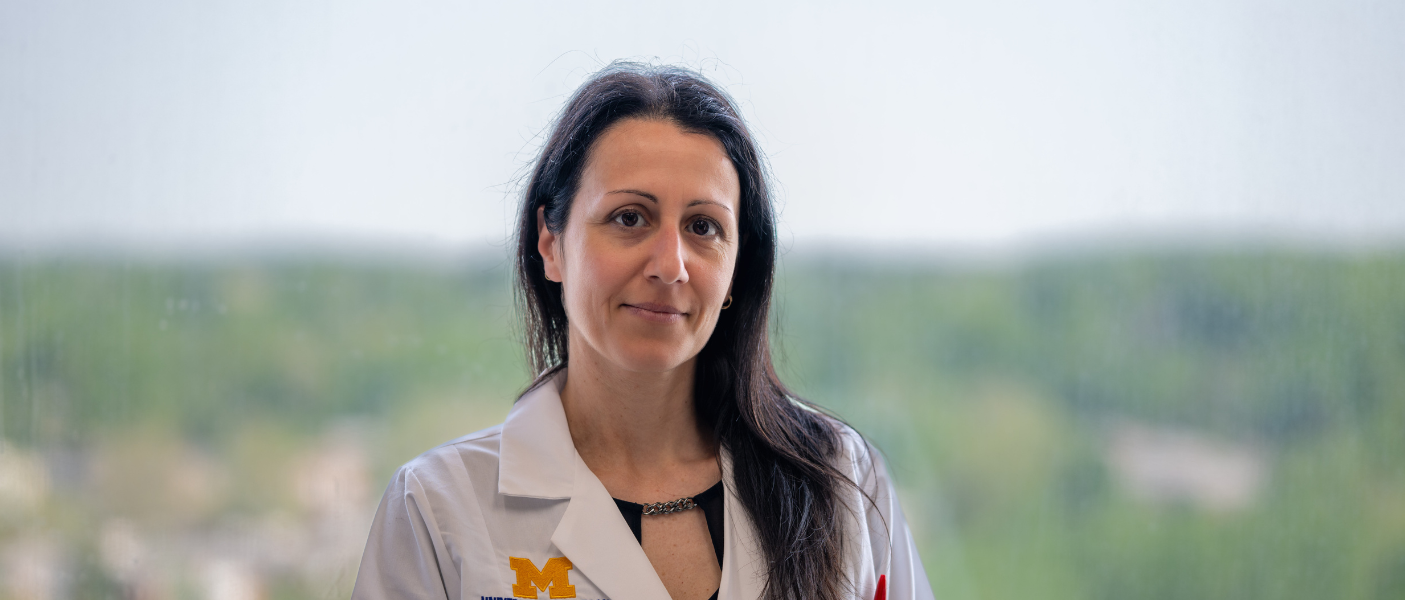

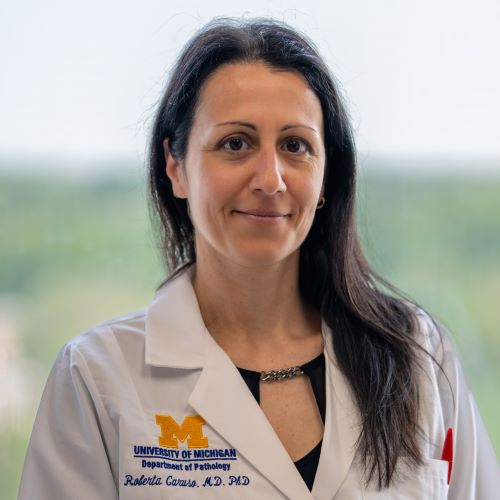 “I grew up in a small town on the Mediterranean Sea, where I used to enjoy the beach, local food and spending time with family. Now, it is just a happy memory,” began Roberta Caruso, MD, PhD, Assistant Professor of Pathology. In high school, Caruso thought she would become a pharmacist, as that was a way she could help people. “I had this desire to understand how medication could improve people’s health.” As she was preparing to graduate from high school, she gave her future more thought and began to reflect on her long-term goals. “My oldest brother had just started medical school, and as I observed his journey and listened to his experiences, it opened my eyes. Maybe I could have a broader impact on patient care and lives. I realized becoming a doctor would allow me to help people more directly. This realization was a turning point in my life.”
“I grew up in a small town on the Mediterranean Sea, where I used to enjoy the beach, local food and spending time with family. Now, it is just a happy memory,” began Roberta Caruso, MD, PhD, Assistant Professor of Pathology. In high school, Caruso thought she would become a pharmacist, as that was a way she could help people. “I had this desire to understand how medication could improve people’s health.” As she was preparing to graduate from high school, she gave her future more thought and began to reflect on her long-term goals. “My oldest brother had just started medical school, and as I observed his journey and listened to his experiences, it opened my eyes. Maybe I could have a broader impact on patient care and lives. I realized becoming a doctor would allow me to help people more directly. This realization was a turning point in my life.”
Caruso attended college at the University of Rome Tor Vergata and earned her medical degree. “During my time in medical school, I really enjoyed internal medicine, especially gastroenterology, as it was so applicable to many people’s lives. I could be very helpful as a gastroenterologist.” This decision led her to the GI division at the University of Rome Tor Vergata and to her mentor, Professor Giovanni Monteleone, a renowned physician-scientist whose research focused on unraveling the molecular mechanisms of intestinal disease, with a special emphasis on inflammatory bowel disease (IBD). “Working alongside Professor Monteleone was a transforming experience. He was a clinician, but he also exhibited a deep love for research. I was deeply inspired by his passion for research and his dedication to advancing our understanding of IBD. This experience led me to pursue a PhD, which was very unusual in Italy at the time. Only two medical students in our graduating class of 160 opted to pursue a PhD.” She joined an experimental physiopathology graduate program, which she found to be extremely rewarding. It allowed her to combine her clinical interests and scientific inquiry.
Caruso joined Tor Vergata University Hospital’s clinical staff as a gastroenterologist while completing a research fellowship. “My life was crazy. I would go to the lab early in the morning and work in the vivarium for a couple of hours, then change clothes and go to the outpatient clinical service. After that was done, I would return to the lab to finish my experiment. It was very challenging, and I was exhausted. I realized I needed to make a choice, and I chose research.”
While Caruso’s training had focused on studying the interactions between immune and non-immune cells in IBD, she became increasingly interested in the role of the gut microbiota in driving IBD. “I recognized my gap in training, so I reached out to Dr. Gabriel Nuñez, Paul de Kruif Professor of Pathology at the University of Michigan, a world-renowned expert in innate immunity, microbial-host interactions, and molecular immunology. I was well acquainted with his pioneering work on identifying NOD2 as the key genetic risk factor for Crohn’s Disease susceptibility, and I knew he was working on host-microbiota interactions in inflammatory conditions. I contacted him and asked if he would have room for me. He accepted me as a postdoctoral student in his lab in 2013. It has been almost 12 years, and I am still here!”
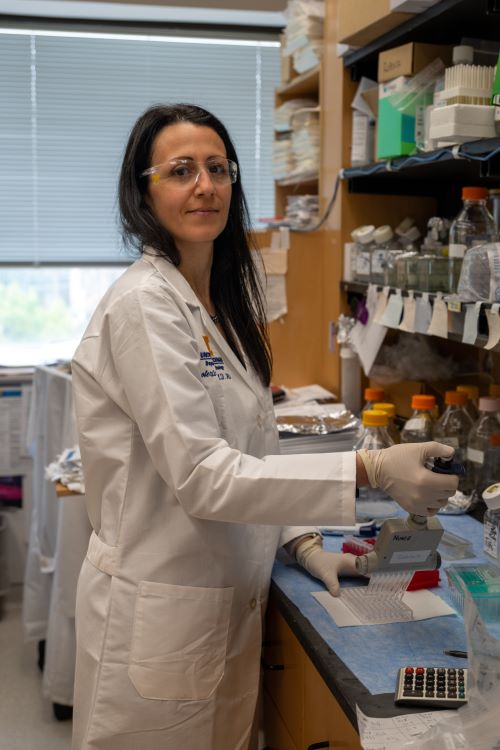 In 2018, Caruso was promoted to Research Investigator, advanced to Assistant Research Professor in 2022, and in 2025, she switched to the tenure track as an Assistant Professor. “The University of Michigan is very competitive, and I did not think the switch to the tenure track would be possible. Then, I was identified as one of three internal, productive researchers who were ultimately promoted to the tenure track positions. I am very, very happy! And Gabriel has been very supportive of this transition to my becoming an independent researcher.” As part of the transition, Caruso will take over teaching responsibilities for Pathology 581 from Nuñez, which introduces students to basic pathophysiologic mechanisms, the molecular basis for disease, and the morphologic expression of human disease. She looks forward to mentoring more students in her laboratory. She is also expanding her service commitments, joining the National Scientific Advisory Committee for the Crohn’s and Colitis Foundation, performing grant reviews, and serving as a faculty reviewer for Molecular and Cellular Pathology graduate student seminars.
In 2018, Caruso was promoted to Research Investigator, advanced to Assistant Research Professor in 2022, and in 2025, she switched to the tenure track as an Assistant Professor. “The University of Michigan is very competitive, and I did not think the switch to the tenure track would be possible. Then, I was identified as one of three internal, productive researchers who were ultimately promoted to the tenure track positions. I am very, very happy! And Gabriel has been very supportive of this transition to my becoming an independent researcher.” As part of the transition, Caruso will take over teaching responsibilities for Pathology 581 from Nuñez, which introduces students to basic pathophysiologic mechanisms, the molecular basis for disease, and the morphologic expression of human disease. She looks forward to mentoring more students in her laboratory. She is also expanding her service commitments, joining the National Scientific Advisory Committee for the Crohn’s and Colitis Foundation, performing grant reviews, and serving as a faculty reviewer for Molecular and Cellular Pathology graduate student seminars.
While in the Nuñez lab, one of her achievements was the development of a mouse model based on the genetic mutations associated with Crohn’s disease in humans. “This required perseverance and resilience. There were many setbacks and failures. Nothing was working, and it was very frustrating in my first year in the lab. I wondered if I was going to make it as a researcher.” Ultimately, she successfully developed a novel mouse model of Crohn’s disease-like colitis that had all the features of the human condition, providing her with a viable tool for examining the underlying disease mechanisms. “This breakthrough, published in Science Immunology, was pivotal to my career. It allowed me to start several independent research investigations.” One of these focused on how diet can modulate intestinal inflammation by targeting disease-causing microbes using this mouse model of Crohn’s disease-like colitis. She recently published these findings in Cell Host & Microbe.
 As an independent scientist, she has made additional breakthrough discoveries. “I am really excited about my most recent work, which isn’t published yet, so I can’t get into too many details. I established a novel mouse model that essentially mirrors the human Crohn’s disease experience of chronic disease characterized by overt segmental relapsing ileocolonic inflammation. This represents the first mouse model of ileitis that is based on genetic mutations associated to Crohn’s disease and recapitulates multiple hallmarks of the human disease. There are no other models of ileitis out there that can do this. I just submitted a grant application for this research. I hope the reviewers find it as exciting as I do.” This pioneering project sits at the crossroads of microbiology, immunology, and next-generation sequencing, achieved through multiple collaborations. Over the next few years, she hopes this mouse model will provide valuable insights that can inform future clinical trials. Caruso also hopes to secure the funding necessary to expand her laboratory and establish herself as an expert in the field of IBD. “This will allow me to mentor more students, which I find to be quite interesting and exciting.”
As an independent scientist, she has made additional breakthrough discoveries. “I am really excited about my most recent work, which isn’t published yet, so I can’t get into too many details. I established a novel mouse model that essentially mirrors the human Crohn’s disease experience of chronic disease characterized by overt segmental relapsing ileocolonic inflammation. This represents the first mouse model of ileitis that is based on genetic mutations associated to Crohn’s disease and recapitulates multiple hallmarks of the human disease. There are no other models of ileitis out there that can do this. I just submitted a grant application for this research. I hope the reviewers find it as exciting as I do.” This pioneering project sits at the crossroads of microbiology, immunology, and next-generation sequencing, achieved through multiple collaborations. Over the next few years, she hopes this mouse model will provide valuable insights that can inform future clinical trials. Caruso also hopes to secure the funding necessary to expand her laboratory and establish herself as an expert in the field of IBD. “This will allow me to mentor more students, which I find to be quite interesting and exciting.”
Outside the laboratory, Caruso takes great joy in her four-year-old son. “He has so much energy! We enjoy taking hikes and I love to see the world through his eyes.” She recently took him to the zoo, where he was awed by the huge elephants and fascinated by the bright pink Flamingos. “But after less than 30 minutes, he was tired of looking at animals, found a stick, and pretended to be mowing the grass,” she added with a chuckle. She recalled when he was just 3 years and 4 months old, “He would correct my English – and he still does this. His language development is so fast! I was amazed that at such a young age, he would be able to correct my English!” This summer, she is looking forward to taking him to Italy for the first time to visit her family, and to reconnect with one of her favorite places – the Mediterranean Sea!
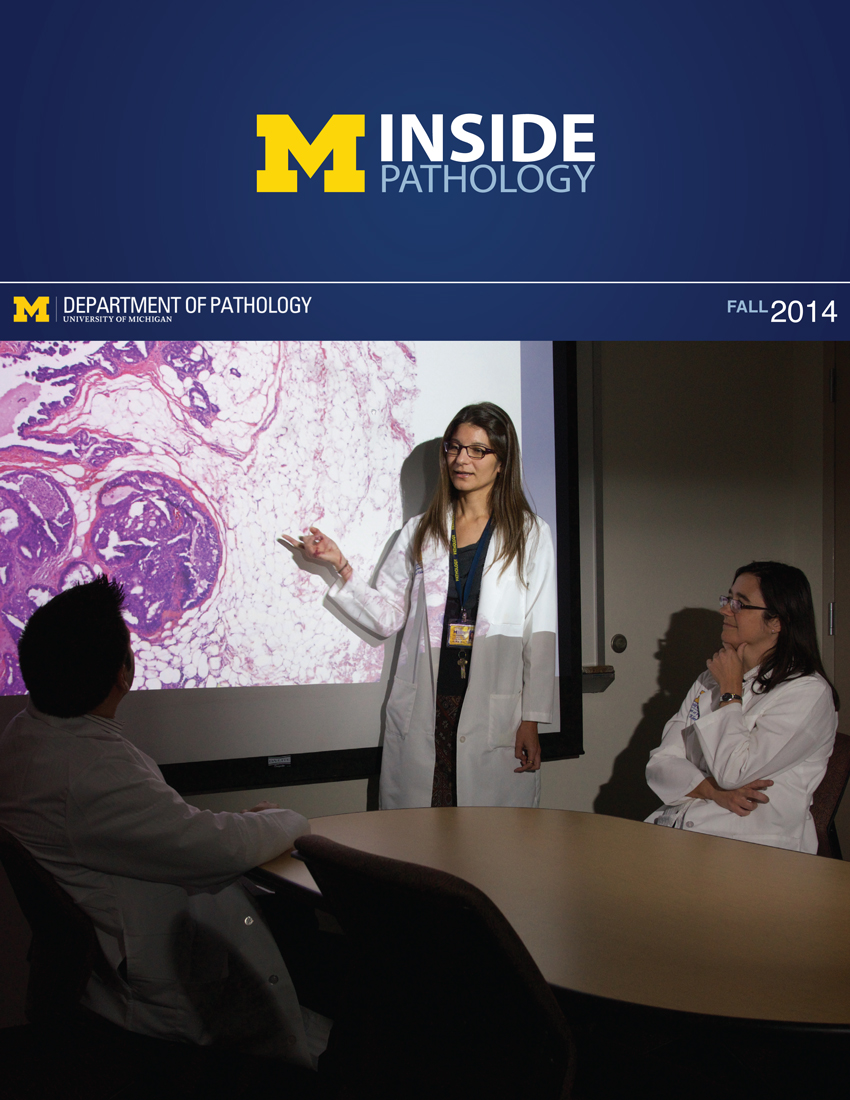 ON THE COVER
ON THE COVER
Breast team reviewing a patient's slide. (From left to right) Ghassan Allo, Fellow; Laura Walters, Clinical Lecturer; Celina Kleer, Professor. See Article 2014Department Chair |

newsletter
INSIDE PATHOLOGYAbout Our NewsletterInside Pathology is an newsletter published by the Chairman's Office to bring news and updates from inside the department's research and to become familiar with those leading it. It is our hope that those who read it will enjoy hearing about those new and familiar, and perhaps help in furthering our research. CONTENTS
|
 ON THE COVER
ON THE COVER
Autopsy Technician draws blood while working in the Wayne County morgue. See Article 2016Department Chair |

newsletter
INSIDE PATHOLOGYAbout Our NewsletterInside Pathology is an newsletter published by the Chairman's Office to bring news and updates from inside the department's research and to become familiar with those leading it. It is our hope that those who read it will enjoy hearing about those new and familiar, and perhaps help in furthering our research. CONTENTS
|
 ON THE COVER
ON THE COVER
Dr. Sriram Venneti, MD, PhD and Postdoctoral Fellow, Chan Chung, PhD investigate pediatric brain cancer. See Article 2017Department Chair |

newsletter
INSIDE PATHOLOGYAbout Our NewsletterInside Pathology is an newsletter published by the Chairman's Office to bring news and updates from inside the department's research and to become familiar with those leading it. It is our hope that those who read it will enjoy hearing about those new and familiar, and perhaps help in furthering our research. CONTENTS
|
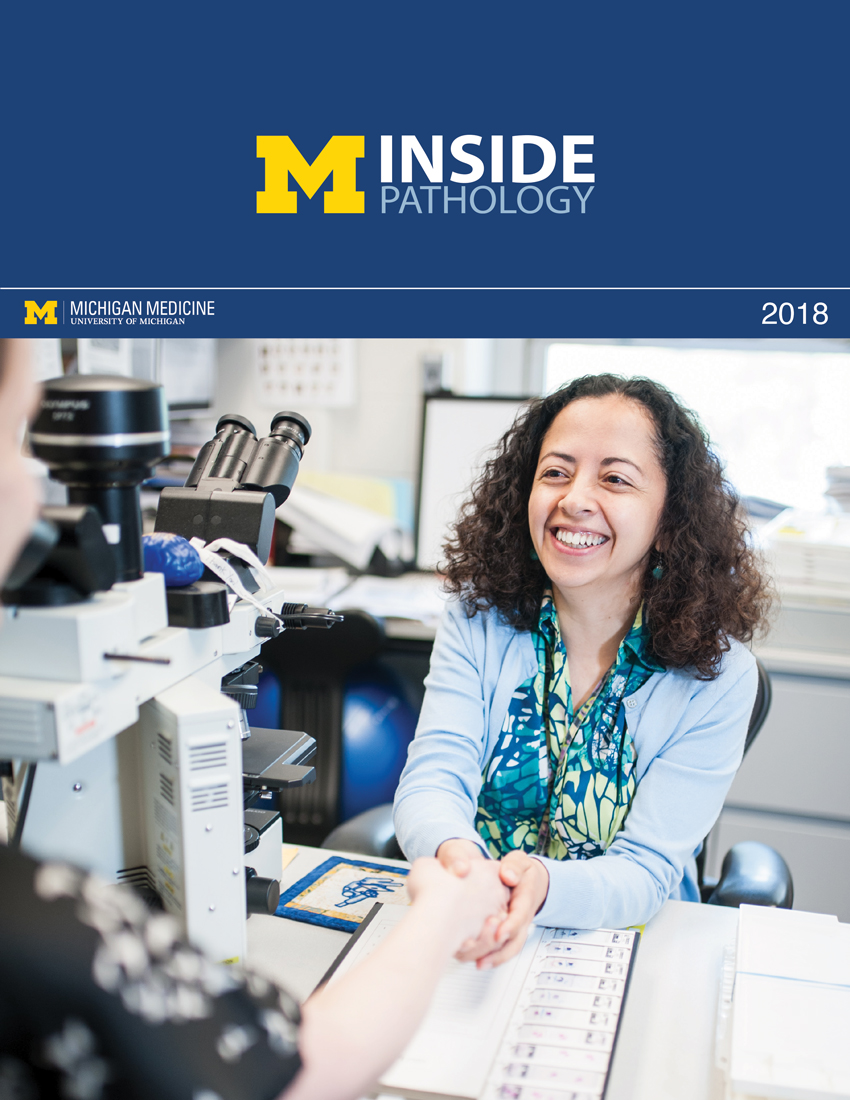 ON THE COVER
ON THE COVER
Director of the Neuropathology Fellowship, Dr. Sandra Camelo-Piragua serves on the Patient and Family Advisory Council. 2018Department Chair |

newsletter
INSIDE PATHOLOGYAbout Our NewsletterInside Pathology is an newsletter published by the Chairman's Office to bring news and updates from inside the department's research and to become familiar with those leading it. It is our hope that those who read it will enjoy hearing about those new and familiar, and perhaps help in furthering our research. CONTENTS
|
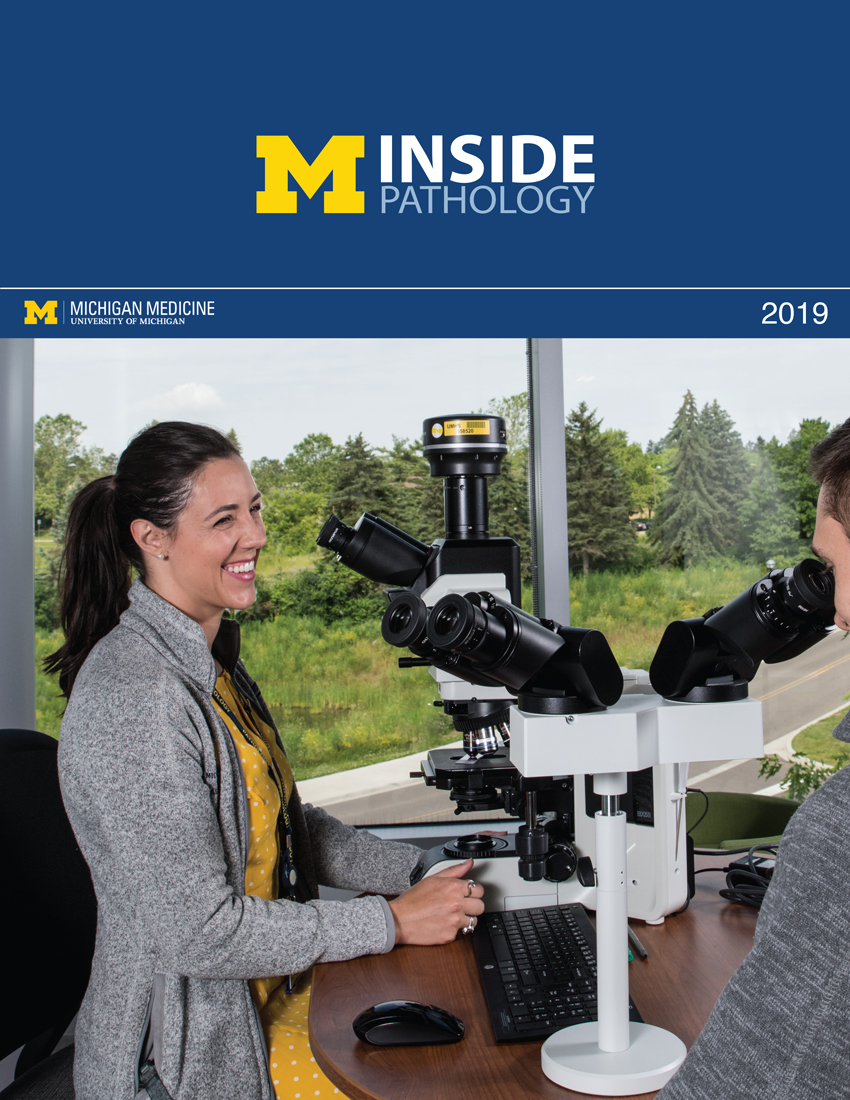 ON THE COVER
ON THE COVER
Residents Ashley Bradt (left) and William Perry work at a multi-headed scope in our new facility. 2019Department Chair |

newsletter
INSIDE PATHOLOGYAbout Our NewsletterInside Pathology is an newsletter published by the Chairman's Office to bring news and updates from inside the department's research and to become familiar with those leading it. It is our hope that those who read it will enjoy hearing about those new and familiar, and perhaps help in furthering our research. CONTENTS
|
 ON THE COVER
ON THE COVER
Dr. Kristine Konopka (right) instructing residents while using a multi-headed microscope. 2020Department Chair |

newsletter
INSIDE PATHOLOGYAbout Our NewsletterInside Pathology is an newsletter published by the Chairman's Office to bring news and updates from inside the department's research and to become familiar with those leading it. It is our hope that those who read it will enjoy hearing about those new and familiar, and perhaps help in furthering our research. CONTENTS
|
 ON THE COVER
ON THE COVER
Patient specimens poised for COVID-19 PCR testing. 2021Department Chair |

newsletter
INSIDE PATHOLOGYAbout Our NewsletterInside Pathology is an newsletter published by the Chairman's Office to bring news and updates from inside the department's research and to become familiar with those leading it. It is our hope that those who read it will enjoy hearing about those new and familiar, and perhaps help in furthering our research. CONTENTS
|
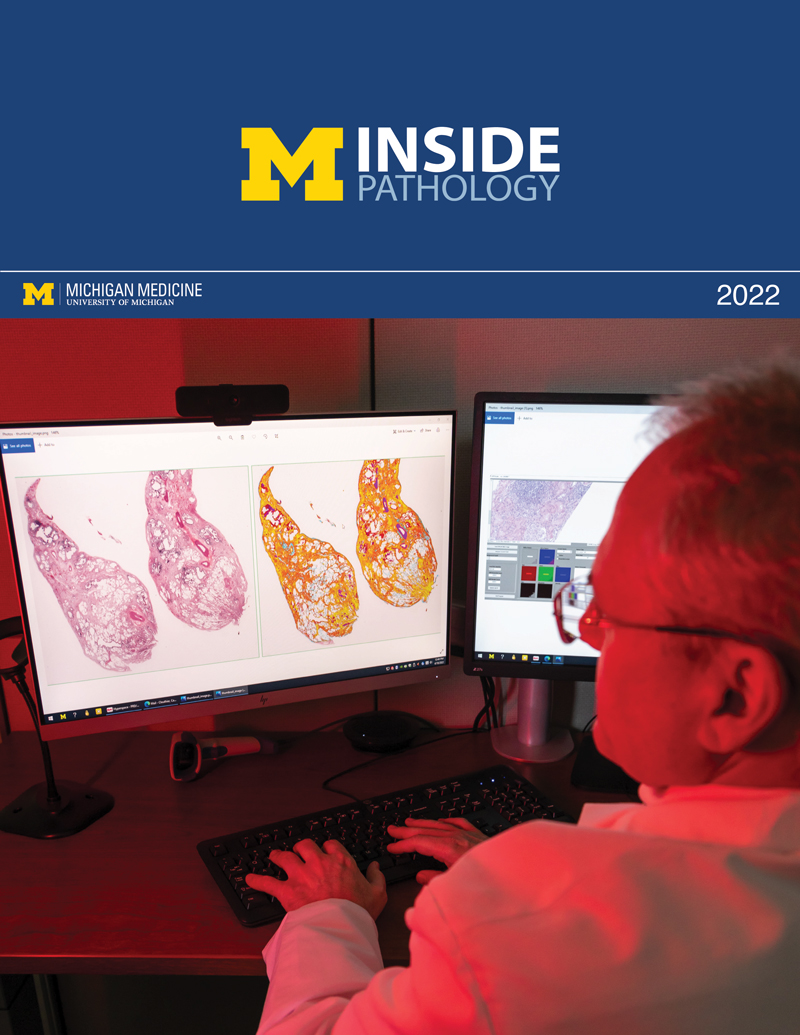 ON THE COVER
ON THE COVER
Dr. Pantanowitz demonstrates using machine learning in analyzing slides. 2022Department Chair |

newsletter
INSIDE PATHOLOGYAbout Our NewsletterInside Pathology is an newsletter published by the Chairman's Office to bring news and updates from inside the department's research and to become familiar with those leading it. It is our hope that those who read it will enjoy hearing about those new and familiar, and perhaps help in furthering our research. CONTENTS
|
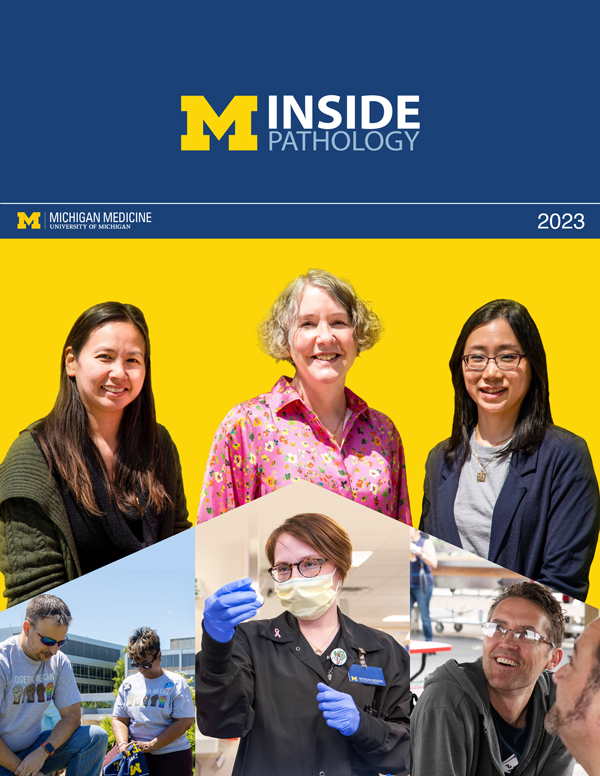 ON THE COVER
ON THE COVER
(Left to Right) Drs. Angela Wu, Laura Lamps, and Maria Westerhoff. 2023Department Chair |

newsletter
INSIDE PATHOLOGYAbout Our NewsletterInside Pathology is an newsletter published by the Chairman's Office to bring news and updates from inside the department's research and to become familiar with those leading it. It is our hope that those who read it will enjoy hearing about those new and familiar, and perhaps help in furthering our research. CONTENTS
|
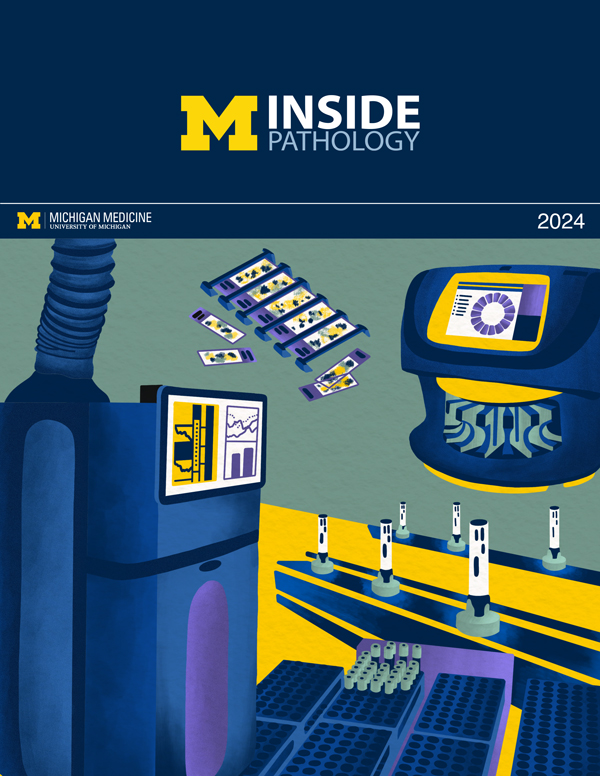 ON THE COVER
ON THE COVER
Illustration representing the various machines and processing used within our labs. 2024Department Chair |

newsletter
INSIDE PATHOLOGYAbout Our NewsletterInside Pathology is an newsletter published by the Chairman's Office to bring news and updates from inside the department's research and to become familiar with those leading it. It is our hope that those who read it will enjoy hearing about those new and familiar, and perhaps help in furthering our research. CONTENTS
|
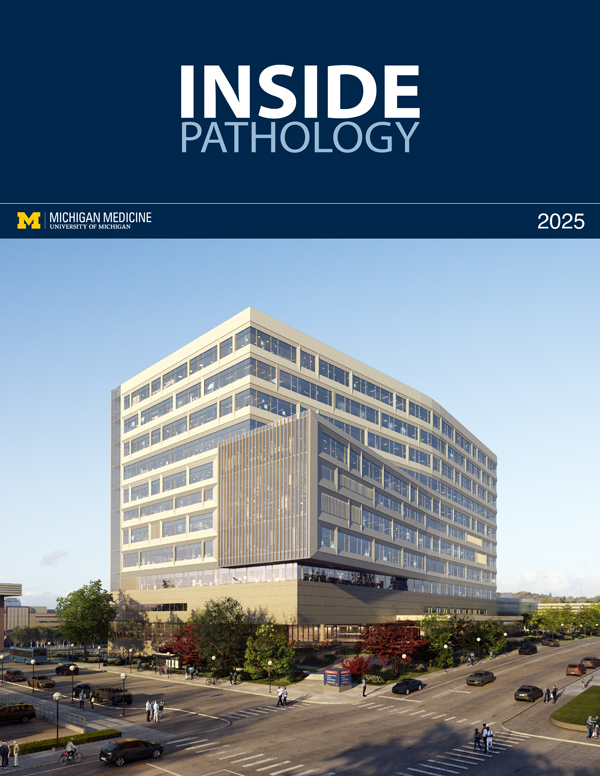 ON THE COVER
ON THE COVER
Rendering of the D. Dan and Betty Khn Health Care Pavilion. Credit: HOK 2025Department Chair |

newsletter
INSIDE PATHOLOGYAbout Our NewsletterInside Pathology is an newsletter published by the Chairman's Office to bring news and updates from inside the department's research and to become familiar with those leading it. It is our hope that those who read it will enjoy hearing about those new and familiar, and perhaps help in furthering our research. CONTENTS
|

MLabs, established in 1985, functions as a portal to provide pathologists, hospitals. and other reference laboratories access to the faculty, staff and laboratories of the University of Michigan Health System’s Department of Pathology. MLabs is a recognized leader for advanced molecular diagnostic testing, helpful consultants and exceptional customer service.